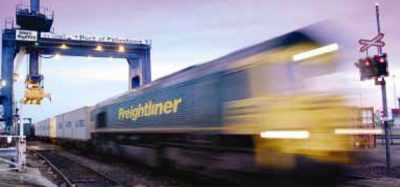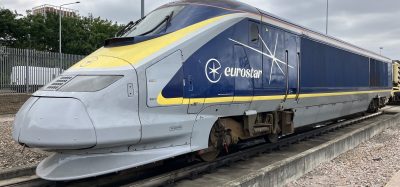Madrid-Barcelona-French Border high-speed railway line
Posted: 27 September 2008 | | No comments yet
Details of the stretch of railway line between Madrid, Barcelona and the French Border, which is managed by RENFE and ADIF.
Details of the stretch of railway line between Madrid, Barcelona and the French Border, which is managed by RENFE and ADIF.
The railway in Spain was created only a few decades after the railway in Great Britain. In 1848, the first stretch of railway line between Barcelona and Mataró was opened for operation in precisely the same corridor in which the Madrid-Barcelona-French Border line is being built today.
The fortunes of the railway in Spain closely mirrored those of the main European railways. Initially, private companies began building different lines through various government tenders and contracts. Subsequently, after a considerable succession of mergers between these first companies, two large private Spanish companies were created, Norte and MZA, which were finally rescued by the State to create the public company RENFE in 1943. The company became the main railway operator in 2005; at the same time, ADIF was founded as a state-operated railway infrastructures administrator.
The first High-Speed Railway opened in Spain in 1992, connecting Madrid with Seville. The line was exclusively for passenger transport and was 470km in length. However, the first studies on the construction of a high-speed railway line actually took place in the 1970s and they were based on the construction of a line covering Madrid-Barcelona-the French Border. Apart from joining the two main cities in the country, this would establish a connection between the Iberian Peninsula and Europe, through what is known as the Mediterranean corridor.
Although the studies began much earlier, the enterprise was not seriously taken up again until 1993, this time including new stretches where there weren’t even any normal railway lines between Madrid and Barcelona (Calatayud-Ricla and Saragossa-Lleida). The founding of GIF, the precursor of ADIF in 1996, represented a definitive step forward for the line and the main section between Madrid and Barcelona was officially opened on 20 February 2008.
Characteristics of the line between Madrid and Barcelona
When the line is finished, it will have a length of 752km. Currently, 652km of the line between Madrid and Barcelona is in use and the line is interoperable in accordance with European legislation. It is designed exclusively for passengers between Madrid and Barcelona and for mixed traffic (passenger and freight) between Barcelona and the French Border. There are also bypass points for the trains on the main line to pass around the stations in Saragossa and Lleida, forming a more direct link between Madrid and Barcelona, which means that the trains do not have to reduce their speeds, thereby optimising journey times.
Infrastructure
The line is designed for a maximum speed of 350km/h, which means that very strict parameters apply to the stretch: the curves must have radii of more than 7.250m with a maximum camber of 140mm and a transversal acceleration of less than 0.39m/s2.
The maximum slope is 25 mil with a ratio of 45.000m between levels and a vertical acceleration of no more than 0.21m/s2.
The platform section type is 14m (double track) with 4.70m between axes.
The viaducts in the line have a total length of 48,964m and the longest viaduct is the one crossing the River Jalón, with a length of 2,238m.
The total length of tunnels is 51,001m with transversal sections of between 75 to 115m2.
Superstructure
The line’s rails are UIC-type with a standard gauge of 1,435m, a distance between axes of 4.70m and ballast thickness under the sleepers of 35cm.
The rail is 60 kg/lineal m with single-block concrete sleepers, with SKL-1-type clips and siliceous ballast.
221 high-speed turnouts have been installed along with 142 normal turnouts and 162 dilation devices. The high-speed turnouts allow the trains to run on the bypass or passing loop tracks at speeds of up to 220km/hour.
There are nine train parking and maintenance points plus twelve passing loop points, so that the line, which has passing loops all along its length, can be operated properly.
Electricity
There are 12 two-phase electrical traction substations, for supplying the power to the overhead lines. The overhead lines make it possible for the trains to run at 350km/h, with a power of 2×25 Kv. The different tunnel lighting systems are connected to the overhead lines, along with the spike heaters and technical building power lines.
Signalling and train protection systems
The high-speed train traffic between Madrid and Barcelona is controlled and protected with an ATP system of ERTMS type, and it also has the ASFA system usually found in the conventional lines of the Spanish Network. Level 1 ERTMS, which is currently in operation, makes it possible for the trains to reach speeds of 300km/h. Level 2, which is currently at the testing stage, will make it possible to increase this maximum speed to 350km/h.
Other additional systems in the line include obstacle detection systems, hot box detectors, fire and air flow detectors in tunnels, vertical impact detectors, dragged materials and derailed axes detectors.
Telecommunications
The line has an optic fibre mesh system with two lines of 32 and 64 fibres. The mobile telecommunication systems are GSM/GSMR-type with base station controls and a central switchboard.
Gauge conversions
To optimise the operation of the network and given that the existing railway system in Spain has a larger gauge (1.668m), various gauge conversion points have been installed so that the trains, which are specially designed to run on dual gauge tracks, can pass from one network (the high-speed one) to another (the traditional one) and vice-versa. Currently, there are five of these points installed.
Regulation and Control Centre
The Line is regulated from one single control centre situated in Saragossa. The traffic is controlled and monitored from this centre, which also controls the security elements (signalling, interlocks, ERTMS), and the power, communications and detector systems in the line.
The centre also houses the security point from where all the installations distributed over the stretch are monitored.
Mobile Materials
The line, which is exclusively for passenger trains, can currently be used by different types of trains, constituting an effective example of interoperability, as the trains are made by different manufacturers including Series 102 (TALGO-Bombardier), Series 103 (Siemens), Series 104 (CAF-Alstom), Series 120 (Caf-Alstom) and Series 130 (TALGO- Bombardier). The first three trains are used exclusively on the high-speed line, whereas the latter two are used on both networks.
The Stations
The construction of a High Speed Line makes it possible to remodel and build new railway stations, which constitutes an additional advantage for cities that can benefit from the renovation of old areas, which in many cases are in bad repair, as the old railway facilities dating from the steam age fell into disuse.
There have been various cases in the construction of the Madrid-Barcelona line, details of which follow.
Extension of old stations
Madrid-Puerta de Atocha
The Puerta de Atocha Station was extensively remodelled for the opening of the first High Speed Railway Line, Madrid-Seville. It is part of a railway complex that is essential for Madrid, as it houses the main suburban traffic station, forming part of a transport exchange with the bus and Metro lines. Its location in the centre of the city is ideal and it will be reinforced as a strategic point in the Madrid railway network with an extension to meet the demand created by a substantial increase of passengers, when the Madrid-Valencia Line opens in 2010, along with the underground tunnel link with the Madrid-Chamartín Station. Currently, the station is the start/destination point of Madrid’s direct connections with Barcelona, Malaga, Seville, Toledo and Valladolid, as well as the rest of the main cities in the traditional Railway Network of Spain, through the aforementioned gauge conversion points.
Calatayud
It has been necessary to construct a new building for high-speed railway passengers, as the high-speed line passes through Calatayud Station, parallel to the normal rail line. Both buildings are connected so that passengers may change from one network to the other.
Lleida
The Madrid-Lleida stretch was the first to be opened in 2003. A monumental canopy was built in this city, whilst respecting the traditional highly-valued architectural style of the buildings and a significant extension will be made to improve the service to passengers. The shops and service areas will also be considerably improved.
Barcelona Sants
The underground station of Barcelona Sants was built at the end of the 1960s when it was becoming a very important place for suburban traffic, and it was decided that the location of the main station in Barcelona, Estación de Francia, was inappropriate for the main traffic flow of the suburban trains.
The remodelling of the station involves the extension of the passenger lobby (whose surface will almost double from 17,900m2 to 35,100m2), the construction of two new underground car parks with space for 2,400 vehicles, the construction of a new bus terminal with 29 platforms, the improvement of the connections between the metro and bus systems and the extension of the services and shopping areas.
New Stations
Three new stations have been built, for proper operation of the line, at Guadalajara, Saragossa and Tarragona.
Saragossa is the most important project, with a total surface area of 180,000m2. The steel roof of the new station is spectacular, with nine arches with supports at the ends, creating a diaphanous surface that provides a lot of light to the lobbies and platforms. The station has 10 tracks with the corresponding platforms and an underground car park, with more than 1,000 spaces.
Camp de Tarragona is the second most important station and it covers an extensive geographical area with a lot of industrial activity and tourism. The passenger building, with a surface of approximately 5,000m2, has extensive areas for passenger services. The underground car park has space for 500 cars and there is also an extensive area outside for buses, taxis and pick-up points.
Investment
The line has required an investment of more than €7,000 million to date, of which €3,460 million have been provided by the European Union’s Cohesion Funds.
Traffic and operation
The territory through which the line passes contains approximately 15 million people – a third of the population of Spain. Madrid and Barcelona cover 73% of this figure, whilst Saragossa, with a population of one million, is the third largest nucleus in the corridor.
In 2004, there were three million journeys on the line and only 10% of the 28 million passengers in the corridor used the high-speed railway. By 2010, it is expected that the three million journeys will have doubled to six million, whilst the percentage of high-speed passengers is expected to reach 40% in a short period of time. In the future, once the extension of the line to the French Border has been commissioned, we can expect significant middle-distance railway traffic, estimated at 30 million passengers by the year 2015. The potential of the Community of Cataluña, where there is a population of seven million, very concentrated in the four province capitals, which will all be serviced by the high-speed train, makes these forecasts completely viable.
It is important to highlight the complexity involved in the construction of the parts of the line accessing the large cities of Madrid and Barcelona. The fact that the HSR has a different gauge to the traditional lines, unlike in other European countries, has made it necessary to extend the line to the terminal stations. The corridors accessing these cities are completely developed, which makes the construction of these tracks, in urban areas, difficult and increases the costs. The last 9km accessing Barcelona Sant were particularly complex, as they were built underground and with hardly any space between the suburban railway and the existing constructions.
The commissioning of the extension of the line between Barcelona and the French Border will likewise involve a significant increase in freight traffic, as the barrier constituted by the different gauges in the Traditional Spanish network and the European network will no longer exist.
Summary
The Madrid-Barcelona-French Border line passes through areas with the highest population densities and greatest rates of activity in Spain, forming the backbone of the Railway Network.
Since the commissioning of the whole Madrid-Barcelona stretch in February 2008, almost three million passengers have already used the high-speed services in the corridor, confirming the most optimistic forecasts. The service between Madrid and Barcelona will be extended to 52 journeys per day, the highest frequency in the whole of the Spanish High-Speed Railway Network, as of September 2008.
By 2012, the stretch of line leading to the French Border will have been completed, connecting Barcelona and its vicinities with the European Railway Network, without having to change the gauge, in contrast to all other railway constructions within Europe since the 19th Century, when the 1.668 gauge system was implemented in Spanish railways.








